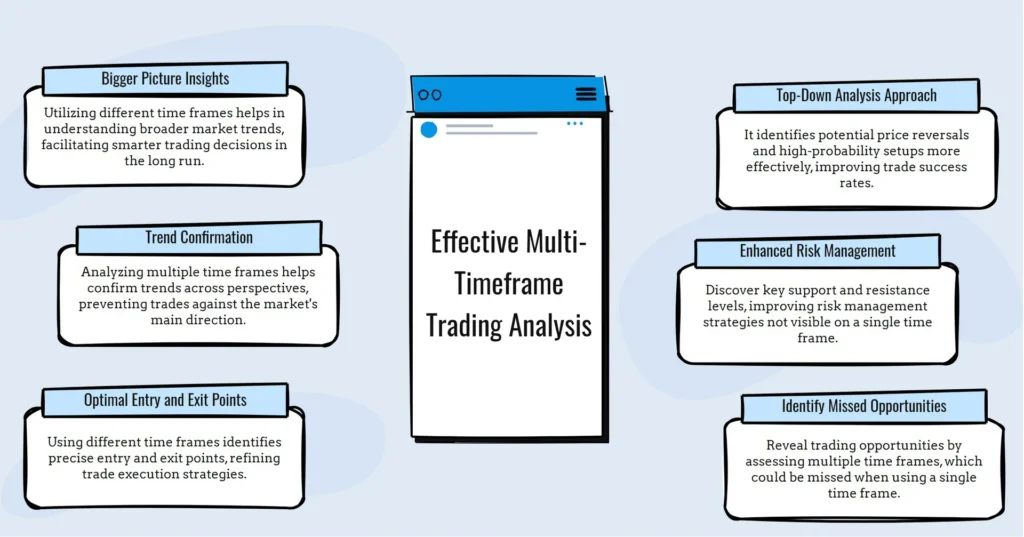
If you’re struggling to consistently profit from forex swing trading, you’re probably not utilizing multiple time frames effectively. Many traders make the mistake of focusing on a single time frame, which often leads to missed trading opportunities and unnecessary losses. By using a multi-timeframe approach, you’ll gain a clearer picture of market movements and identify high-probability trade setups with greater accuracy.
Purpose of Using Multiple Time Frames
Nearly every successful swing trader relies on multiple time frame analysis to gain a comprehensive view of the market. You’ll find that using different time frames helps you see both the bigger picture and the finer details of market movements, leading to smarter trading decisions.

Using a top-down analysis approach helps identify potential price reversals and high-probability setups more effectively.
When you analyze multiple time frames, you’re able to confirm trends across different perspectives. This trend confirmation helps you avoid trading against the market’s main direction. You’ll also improve your risk management by identifying key support and resistance levels that mightn’t be visible on a single time frame.
One of the biggest advantages is finding better entry and exit points. While longer time frames show you the overall trend, shorter ones help you fine-tune exactly when to enter or exit trades.
Multiple time frame analysis also reveals trading opportunities you might miss if you’re only looking at one time frame. For instance, you can spot a long-term uptrend on a weekly chart, then use shorter time frames to find ideal entry points during pullbacks.
This approach helps you filter out market noise and focus on high-probability trades that align with the bigger market picture.
Choosing Time Frames for Swing Trading
Successful swing trading depends on selecting the right combination of time frames for your analysis. You’ll want to focus primarily on the daily chart as your main reference point, as it provides the clearest view of significant market trends while filtering out unnecessary noise. This time frame gives you a solid foundation for identifying potential trade opportunities.

To refine your analysis, you should combine the daily chart with both 4-hour chart and weekly charts. The weekly charts help you understand the bigger picture and long-term trends, while the 4-hour chart lets you spot short-term trends and better timing for your entries and exits. This multi-timeframe analysis approach helps you make better trading decisions.
While you might be tempted to look at very short time frames, it’s best to avoid anything shorter than the 1-hour chart for swing trading. These shorter intervals often create confusion with too much market noise.
Instead, stick to the combination of daily, 4-hour, and weekly charts – this trio will give you the most reliable signals and help you maintain a clear perspective on market movements.
Determining Primary Trend Across Time Frames
Determining the primary trend requires a systematic top-down approach using multiple time frames. You’ll want to start with higher time frames like weekly or monthly charts to identify the overall market direction, then work your way down to shorter periods for precise entry points.
| Time Frame Level | Purpose and Analysis |
|---|---|
| Higher (Weekly/Monthly) | Establish primary trend direction |
| Intermediate (Daily) | Confirm trend continuation |
| Lower (4-Hour) | Find entry/exit points |
| Lowest (1-Hour) | Fine-tune timing |
Multi-timeframe analysis helps you confirm trends across different periods, making your trading decisions more reliable. When you spot a trend on the weekly chart, check if it’s supported by the daily and 4-hour charts. You can use technical indicators like moving averages or MACD to verify your analysis, but don’t overcomplicate things.
Stick to a consistent combination of time frames – if you’re swing trading, use weekly charts with daily or 4-hour periods. Remember, short-term time frames should support what you’re seeing in the bigger picture. By following this top-down approach, you’ll develop a clearer understanding of market direction and improve your trading results.
Enhancing Entry and Exit with Time Frames
Now that you understand how to identify the primary trend, let’s focus on using multiple time frames to pinpoint ideal entry and exit points. Multiple time frame analysis can dramatically elevate your trading accuracy by giving you a clearer picture of market movements at different levels.

Incorporating the 50 EMA can provide additional confirmation of trend strength across time frames.
You’ll want to start with top-down analysis, using longer time frames to confirm the main trend direction. Once you’ve established this, switch to shorter time frames to fine-tune your entry and exit points.
For example, if you spot a bullish trend on the daily chart, you can use the 4-hour or 1-hour charts to find the best moment to enter your trade.
This approach improves your entry and exit precision by helping you avoid weaker setups. When you see a potential trade setup, confirm it across different time frames – if the signals line up, you’ve got a stronger case for entering the market.
You’ll also improve your risk management by setting more strategic stop-loss levels based on key support and resistance levels visible on multiple time frames.
Remember to stay consistent with your chosen time frame combinations to develop a reliable trading routine.
Common Mistakes in Time Frame Analysis
Many traders makes the same mistakes when using multiple time frame analysis, which can derail even the most promising trading strategies. One of the biggest mistakes you’ll want to avoid is neglecting your primary time frame, which provides essential context for your overall trading decisions.
Understanding key technical indicators like Moving Averages and RSI across different timeframes can help prevent analysis paralysis.
When practicing multi-time frame trading, you shouldn’t overcomplicate your analysis by using too many indicators or charts. This often leads to confusion and indecision. Simple is usually the best approach.

It’s also important to pay attention to conflicting signals between different time frames – don’t ignore them, as they’re often warning signs that require closer examination.
You’ll need to maintain proper risk management regardless of which time frames you’re analyzing. Don’t let the complexity of multiple charts distract you from setting appropriate stop-losses and take-profit levels.
Additionally, avoid the temptation to focus solely on short-term trends while ignoring the bigger picture.
Remember to strike a balance with your analysis – using too few time frames can leave you with insufficient data, while too many can overwhelm you (analysis paralysis).
Stick to two or three time frames that align with your trading strategy for the best results.
Swing vs. Other Trading Styles Time Frames
Swing trading stands apart from other trading styles primarily through its distinctive time frame approach. When you’re swing trading, you’ll hold positions for several days to weeks, which sets it apart from both shorter and longer-term trading styles.
Your time frame analysis will focus mainly on daily and weekly charts, giving you a balanced view of market movements. Using price action patterns like head and shoulders formations can help identify ideal entry and exit points for swing trades.

Unlike day traders who need to constantly monitor minute-by-minute changes, you’ll find swing trading offers a more relaxed approach. While day traders and scalpers work with very short-term trading windows, often closing positions within minutes or hours, swing traders can take their time to analyze and execute trades. You’ll be looking at broader market moves rather than tiny price fluctuations.
On the other hand, position trading focuses on longer-term trends, sometimes holding trades for months or years. As a swing trader, you’ll primarily use technical analysis to spot medium-term opportunities, making it a middle-ground approach.
This makes swing trading particularly appealing if you’re looking to balance trading opportunities with a manageable time commitment, avoiding both the stress of rapid trading and the extended waiting periods of position trading.
Benefits of Multi-Timeframe Analysis Strategy
Through multi-timeframe analysis, you’ll gain several powerful advantages that can transform your trading results.
When you examine price movements across different time frames, you’re able to see both the big picture and the smaller details, giving you a more complete understanding of market conditions. The 123 pattern strategy provides additional confidence when analyzing breakouts across multiple timeframes, helping validate potential trade setups.
One of the key benefits is augmented risk management, as you’ll reduce the chances of falling for false signals by confirming trends across multiple timeframes. You’ll also experience improved decision making because you’ll have different perspectives on market trends, helping you make better choices about when to enter and exit trades.
Multi-timeframe analysis helps you with identification of trends and patterns that mightn’t be visible when looking at just one timeframe. This leads to better strategic trade management as you can spot more profitable entry and exit points.
You’ll also gain more confidence in your decisions since you’re validating signals across different time periods.
Your Questions Answered
Can Multiple Time Frame Analysis Be Automated Using Trading Software?
Yes, you can automate multiple time frame analysis using trading platforms and coding languages like MQL4/5, Python, or R. You’ll need programming skills or pre-built indicators to scan different timeframes simultaneously.
How Often Should Traders Switch Between Different Time Frame Charts?
You should check higher time frames at the start of your trading session, then monitor lower ones throughout the day. Don’t switch too frequently – it’s best to stick to 2-3 structured reviews daily.
What Indicators Work Best When Analyzing Multiple Time Frames Simultaneously?
You’ll find RSI, MACD, and moving averages work best across multiple timeframes. They’re effective trend-following tools that help confirm signals when aligned. Also consider Fibonacci retracements for support and resistance levels.
Does Multiple Time Frame Analysis Work Equally Well in Ranging Markets?
You’ll find multiple timeframe analysis isn’t as effective in ranging markets because price action tends to be more choppy and unpredictable. It’s better suited for trending markets where directional momentum is clearer.
How Many Currency Pairs Should Traders Monitor Using Multiple Time Frames?
You’ll want to limit yourself to 3-4 currency pairs when using multiple time frames. It’s better to master trading fewer pairs thoroughly than to spread yourself too thin across many currencies.
summary
You’ll find that using multiple time frames in forex swing trading isn’t just helpful – it’s essential for your success. By analyzing weekly charts for the big picture, daily charts for trend confirmation, and shorter time frames for precise entries, you’re building a complete trading strategy. Remember to stay consistent with your approach, avoid information overload, and always let the higher time frames guide your overall trading decisions.
